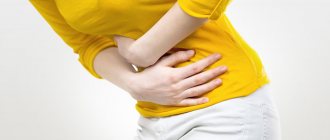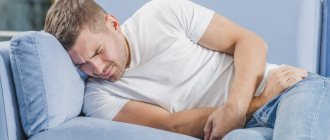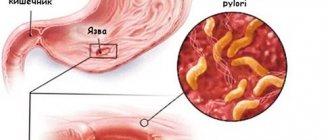- Causes of pain
- Diagnostics
- Possible diseases
- Treatment
- Our doctors
The right side of the abdomen contains several vital organs. The development of pathology in one of them provokes characteristic pain. Knowing the causes of this condition is necessary for timely consultation with a doctor and will help avoid serious complications.
Most often, women are bothered by pain in the lower abdomen. But in some cases this symptom manifests itself in men. Knowing the possible causes, you can immediately consult a doctor for help if you suspect a pathology. This will avoid complications and significantly speed up recovery.
Causes of pain
Typically, pain in the lower abdomen in men is associated with urological problems. But it also appears when other organs are affected:
- gastrointestinal tract;
- excretory system;
- musculoskeletal system.
The appearance of unpleasant sensations in the lower abdomen in men is due to a pathological process, because normally there is no pain. It can be of different types:
- inflammation;
- infection;
- ulceration;
- fluid accumulation;
- weakness of the ligamentous apparatus.
There are many reasons why a man’s lower abdomen hurts. To make an accurate diagnosis, a comprehensive examination of the patient is necessary.
Generalized pain
In this case, the patient complains of discomfort throughout the abdomen. The syndrome can be caused by the following conditions.
- Constipation. The situation is accompanied by bloating, loss of appetite, and sometimes nausea. The solution to the problem is drinking plenty of fluids and eating foods rich in fiber.
- Irritable bowel syndrome. The condition is characterized by colicky pain, accompanied by diarrhea or constipation, and bloating. Therapy is focused on eliminating the causes of the disease and includes diet.
- Back pain can radiate to the abdomen, which indicates disorders in the lumbosacral spine and requires consultation with a neurologist.
Diagnostics
The examination of the patient begins with examination, collection of complaints and anamnesis, and palpation. Based on the results, the doctor makes a preliminary diagnosis, which is clarified by additional diagnostic methods:
- general blood test - will indicate the presence of inflammation and infection;
- a general urine test will detect kidney damage;
- Ultrasound - will show changes in tissue and size of internal organs;
- Prostate fluid test will detect problems with the prostate.
A complete and correct diagnosis is half the success in treating the disease. Therefore, you need to contact only trusted medical institutions with qualified doctors.
Discomfort in the navel area
Discomfort may be a symptom of the following pathologies.
- Inflammation of the appendix. If the condition is accompanied by fever, nausea and loose stools, you should immediately consult a doctor.
- Stomach ulcer or gastritis. The pain is burning in nature, accompanied by belching, indigestion, nausea and vomiting. If there is blood in the vomit or the stool is black, this indicates internal bleeding and requires urgent medical attention.
Possible diseases
When a man has pain in the lower abdomen, several diseases can be suspected at once. Main diagnoses:
- cystitis, urethritis;
- prostatitis;
- vesiculitis;
- BPH;
- urolithiasis disease;
- diverticulitis;
- testicular cysts;
- peptic ulcer;
- pyelonephritis;
- oncology;
- orchitis and orchiepididymitis;
- varicocele;
- appendicitis;
- inguinal hernia and its strangulation;
- duodenitis.
The list of diseases that cause pain in a man’s lower abdomen is quite long. Only a doctor can correctly diagnose and prescribe treatment. And the patient’s life sometimes depends on well-chosen therapy.
When the lower back and lower abdomen hurt in the center
Pain concentrated in the center of the abdomen in its lower part most often indicates certain disturbances in the functioning of the organs of the urinary system, prostate gland or spinal column.
- Renal colic.
When the flow of urine through the ureter is disrupted, a person develops renal colic. The ureter is a thin tube that stretches from the kidney to the bladder. Passage failure most often occurs due to blockage of the ureter by stones. However, it cannot be ruled out that its obstruction occurred against the background of an inflammatory process, or that it was compressed by a tumor neoplasm. Moreover, the tumor can grow both from the organ itself and from tissues that are in close proximity to the ureter.
Pain with renal colic has the following features:
- The pain is paroxysmal.
- Pain forces a person to constantly move in order to find a position that will bring relief.
- The pain radiates to the groin, genitals, and pubis.
- The person’s general health is impaired, and nausea may occur.
- Body temperature may rise.
- There may be blood in the urine.
- Kidney pathologies.
A man may have an affected left ureter or kidney if he experiences the following symptoms:
- The pain is localized above the lumbar spine.
- The volume of urine increased, or, on the contrary, became insignificant.
- Body temperature has increased.
- The urine contains impurities of blood, pus, and mucus.
- The urine smells extremely unpleasant.
- Pathologies of the spinal column.
Pain in the lower abdomen and back is a symptom of many spinal pathologies: osteochondrosis, ankylosing spondylosis, spondylosis, etc.
In this case, the person will experience the following symptoms:
- The pain does not migrate and is localized in one area.
- The pain is not diffuse and has a clear localization.
- Pain shoots down my leg.
- The stool is not disturbed, there are no signs of poisoning, such as nausea and vomiting.
- In the morning, the pain hampers movement, and during the day it fades away.
- The lower limb on one side may lose sensitivity, sometimes there is a feeling that “goosebumps” are running over it.
Treatment
Based on the diagnosis, the doctor develops a treatment plan. It may include several groups of medications:
- antibiotics;
- anti-inflammatory;
- enveloping (for peptic ulcer);
- chemotherapy.
In some cases, conservative therapy is powerless. Then the patient is indicated for surgical intervention. In order for it to pass without complications, you need to carefully choose a doctor and a clinic for treatment.
Pain in the lower abdomen in men is no less dangerous than in women. They can be a signal of the development of a tumor process or an inflammatory disease. A timely and correct diagnosis is half the success of treatment. Therefore, it is important to find a good clinic for examination and trust your doctor. Then it will be possible to quickly recover, avoid complications, and in some cases save the patient’s life.
Read also: Pain in left side
Dear patients! Remember that only a qualified doctor can make an accurate diagnosis, determine the causes and nature of the disease, and prescribe effective treatment. You can make an appointment with our specialists or call a doctor at home by calling 8-(4822)-33-00-33
Be healthy and happy!
Treatment for lower abdominal pain in men
In order for the doctor to make the correct diagnosis, it is important to correctly describe your pain to him: nature, location, strength, duration. This can be a useful indicator to determine the cause.
Associated symptoms such as diarrhea, vomiting and urinary problems will also help determine the cause.
Diagnostics
In addition to interviewing the patient, the doctor will also examine the abdomen to determine if there is pain when pressing certain areas, and will also check for lumps.
Additional tests will vary depending on the suspected disease. This includes a urine, stool or blood test and an abdominal scan.
Consultation with additional specialists may be required because the cause of abdominal pain can be difficult to determine.
Rodion VasilevskyUrologist-andrologist of the highest category
Modern methods of treatment
Treatment methods directly depend on the cause of the pain and are described above. In each case, the diagnosis and tactics will be determined by the doctor.
Possible causes of discomfort
The causes of pain in the right side are varied. This includes an inactive lifestyle, poor nutrition, failure to comply with personal hygiene rules, infections, and helminthic infestations. Some diseases are caused by genetics.
Diseases that cause pain in the right side of the abdomen, as a rule, do not have a specific clinic. Most of them lead to indigestion, changes in stool, and increased temperature as an inflammatory process occurs. Therefore, it is better not to start self-treatment, but to seek qualified medical help.
In addition to the pain syndrome, additional signs arise that will help a man understand which system of the body has failed and which doctor needs to be consulted. So, if pain in the abdomen is caused by liver disease, then a consultation with a hepatologist is necessary, and if it is kidney dysfunction, then you need to consult a urologist.
In case of intense, prolonged pain, you should not wait, but rather call an ambulance
Causes of heaviness in the lower abdomen
This area contains the small and large intestines.
There are many reasons for discomfort. Most often they are associated with inflammation of the mucous membranes, which are caused by various bacteria, fungi, and viruses. Heaviness in the lower abdomen can be caused by a decrease in the production of intestinal enzymes, impaired absorption of food, and infection with helminths. The cause may also be the formation of a hernia, which puts pressure on neighboring tissues and organs. The problem may also be a malfunction of the urinary system, in particular, inflammation of the bladder. In women - organs of the reproductive system: uterus, ovaries.
When the lower abdomen hurts above the pubis
Pain concentrated in the lower abdomen directly above the pubis can characterize the following disorders in the body:
- Prostatitis in the acute phase.
When prostatitis worsens, the pain is sharp, stabbing, covers the entire perineum, extends to the testicles and groin, to the rectum and sacrum. If prostatitis worsens not for the first time, then the pain becomes nagging in nature. The cause of exacerbation of inflammation can be alcohol abuse, exposure to cold, and overwork.
- Cystitis.
When the bladder becomes inflamed, a man experiences the following symptoms:
- Pain when emptying the bladder, which prevents it from being completely emptied.
- Frequent urge to urinate.
- The appearance of blood in the urine.
- Urine becomes cloudy.
- The pain in the pubic area becomes nagging.
- Body temperature rises.
- If the disease is severe, vomiting and nausea may occur.
- Bladder cancer.
When the tumor reaches an impressive size, it begins to cause difficulty emptying the bladder. Blood impurities appear in the urine. Further progression of the disease resembles the symptoms of cystitis, lumbar pain and pain above the pubis are added, which cannot be eliminated by taking antispasmodics. Body temperature rarely increases with bladder cancer.
- BPH.
Urination becomes more frequent, and the man begins to wake up at night to empty his bladder. The prostate increases in size, which leads to the fact that a man begins to experience pain during urination. The sensations are sharp, stabbing. In addition to urinary retention, lower back pain is observed.
- Prostate cancer.
When the tumor grows, the first symptoms of the disease appear:
- Pain in the perineum.
- Frequent urge to urinate.
- Blood appears in urine and semen.
- The stream of urine loses its former pressure.
- Vesiculitis.
Inflammation of the seminal vesicles is manifested by the following symptoms:
In addition to pain, the man begins to worry about urinary problems. During emptying of the bladder, sharp pain in the abdomen will occur, and the urge becomes frequent. Possible urinary retention. In addition, erection suffers.
When the tumor begins to metastasize, the person will lose weight and lose appetite. Chest pain appears, weakness does not subside even after proper rest. When the skeleton is damaged, pain appears in the joints and bones.
- The pain spreads to the sacrum and becomes stronger during bowel movements or when the bladder is full.
- Pain always accompanies erection and ejaculation.
- Blood impurities appear in the semen.
- Urination is impaired.
- General health is disturbed.
Necessary studies to make a diagnosis
To determine the true cause of a man’s pain, which is localized in the lower abdomen, he will need to visit a doctor. This could be a gastroenterologist or urologist.
During your initial visit you will need to go through the following procedures:
- Answer the doctor’s questions regarding how long the man has been bothered by pain, and whether it is related to other situations. The doctor will be interested in how intense the pain is, what its nature is, and where exactly it is concentrated.
- After the interview, the doctor will begin to palpate the abdominal wall. You may need to palpate the prostate, which is done through the rectum.
- If necessary, the specialist will give the patient a referral for the following diagnostic procedures:
- Ultrasound of organs located in the abdominal cavity.
- Ultrasound of the prostate.
- Contrast X-ray examination of the intestine.
- Ultrasound of the pancreas.
- Ultrasound of the urinary system.
If a tumor is detected, tissue sampling will be required. A biopsy is most often performed during surgery, when, after excision of the tumor, a small part of it is separated and sent for histological analysis. Before a patient is referred for surgery, a number of preparatory measures are carried out, including an MRI or CT scan.
If the doctor suspects a pathology of the urinary tract, then you will need to submit your urine for analysis according to Nechiporenko and for bacteriological culture.
If a patient is diagnosed with prostatitis, then a bacteriological analysis of prostate juices is necessary.
Inguinal hernia
A hernia in the groin area is the most common of all types of hernias, and is 6 times more common among men than among women. With this disease, the peritoneum and internal organs of the abdominal cavity (usually the intestines) protrude under the skin through the inguinal canal. This is faced by men who are associated with hard work and have an enlarged inguinal and umbilical ring. A hernia occurs because the thinnest and weakest parts of the abdominal wall are located in the groin area.
At first there may be no pain, just a bulge. Sometimes it can be reduced, but in a lying position it may disappear. But with further development of the disease, complications are possible. Thus, pain in men in the left groin is caused by strangulation of a left-sided inguinal hernia. The same can happen on the right side if the protrusion occurs on the right.
Overeating as a provoking factor
Often the cause of heaviness in the lower abdomen lies in a violation of the diet, when too much fried, smoked food, as well as alcohol is consumed. Low-alcohol drinks containing carbon dioxide are dangerous. Situations are harmful when a person abstains from food for several hours and then finds himself on a rich feast. A sudden filling of the stomach after 15-20 minutes can result in a feeling of discomfort in both the upper and lower abdomen due to active gas formation. It is difficult for a person to take a deep breath, laugh, or bend over. Symptoms usually go away after a few hours. If they repeat after every meal, this may be a sign of gastrointestinal disease6.
What to do when you overeat
- You need to switch from food to warm tea with mint. You need to drink it slowly - this helps to relax the gastrointestinal tract.
- Do not hold back the belching - this will release excess air from the stomach.
- Under no circumstances should you lie down. Try to maintain an upright position for at least 3 hours.
- It is best to walk slowly at a calm pace for 25-30 minutes. This stimulates the gastrointestinal tract.
- You can chew gum for 15-20 minutes - this activates the digestion process.
- On the Internet you can often find advice to take multienzyme drugs. However, they must be prescribed by a specialist; doctors do not recommend doing this on your own.
The cause of heaviness in the lower abdomen may be overeating. Photo: motortion/Depositphotos
Diseases of the reproductive system
Orchitis is inflammation of the testicles. In addition to pain in the groin, there is pain in the perineum and the affected testicle. If the disease has become chronic, then the man experiences aching pain in the groin.
Testicular torsion. Causes severe groin pain in men. It is acute, initially occurs in the scrotum, and very suddenly. The pain is so severe that it can cause nausea and vomiting.
Funiculocele is a cyst of the spermatic cord. Causes discomfort in the scrotum, which intensifies after physical activity, and a feeling of fullness. Pain is more often observed during sexual intercourse.
Varicocele is a varicose vein of the spermatic cord. The pain can be either mild or severe. Shooting and burning pain in the groin in men is most often caused by varicocele.
Other possible reasons:
- acute prostatitis,
- prostate adenoma,
- vesiculitis,
- balanoposthitis,
- prostate cancer.
Some diseases that cause diarrhea and stomach pain
Diarrhea is divided into acute and chronic. Acute lasts up to 2 weeks1. If liquid feces are observed for longer than 4 weeks, they speak of a chronic form2. Both options can occur for the same diseases.
Intestinal infections and toxic infections
Acute diarrhea most often has an infectious nature1 and occurs as a result of pathogenic microorganisms or their toxins entering the body through the consumption of contaminated water and food, or neglect of personal hygiene rules1.
Pathogens can be 1:
- bacteria such as Escherichia coli, Salmonella, Shigella, Vibrio, Campylobacter, Yersinia;
- viruses, for example enteroviruses, rotaviruses or adenoviruses;
- various protozoan microorganisms: amoeba, dysentery, lamblia, etc.
Loose stools can occur from several to 30-40 times a day1; it is often accompanied by cramping pain in the abdominal cavity, fever, and weakness. The appearance of nausea and vomiting may be associated with damage to the stomach and small intestine, that is, with the development of gastroenteritis1.
Nausea, weakness, abdominal pain and diarrhea, the appearance of mucus and blood in the stool, false urge to defecate more often occur with colitis, that is, inflammation of the colon1.
Intestinal infections, especially in children and the elderly, are dangerous due to dehydration1. Therefore, if you experience frequent vomiting or the appearance of liquid stool in your stool, you should contact an infectious disease specialist.
Traveler's diarrhea
Most often, tourists visiting Central and Western Africa and India encounter it. What to do: diarrhea and abdominal pain can be associated with changes in diet, quality of water consumed, acclimatization, time zone changes and other stresses. The causative agents of the infection are some strains of Escherichia coli1. Abnormal bowel movements occur upon arrival or in the first two days of stay in a new country, usually up to 3 times a day, accompanied by cramping pain in the abdominal cavity, lasting on average no more than a week1, you can cope with it yourself. If symptoms persist longer, consultation with a doctor and examination are necessary.
Food allergies
More common are intolerance to cow's milk and products made from it, as well as eggs, nuts, fish, cereals, strawberries, chocolate, coffee, tomatoes, etc.2. Therefore, if every time after consuming a particular product, loose stools appear and the stomach begins to hurt, then perhaps we are talking about an allergy.
Abnormal bowel movements due to allergies are associated with the action of inflammatory mediators2. They cause swelling of the intestinal walls, increase the secretion of fluid into the intestinal cavity and cause spasms.
Excluding allergenic foods from the diet helps normalize the condition. Their repeated inclusion in the diet leads to stool dilution.
Lactase deficiency and celiac disease
Lactase deficiency is a congenital or acquired lack of the enzyme lactase, which breaks down cow's milk protein, or lactose. Its classic manifestations are pain, bloating and loud rumbling in the abdominal cavity that occurs after eating dairy products, preceded by the release of liquid stool with an unpleasant sour odor.
What to do if you have abdominal pain and diarrhea due to lactase deficiency? Of course, exclude milk and products in which it is used from your diet.
Celiac disease is intolerance to the protein of cereals and gluten. Wheat and rye contain the most gluten, so abdominal discomfort often occurs after eating flour products. Excluding grains from the diet helps normalize the condition.
Irritable bowel syndrome
Irritable bowel syndrome (IBS) is a functional disorder2. The reason for its development still remains unclear. It is believed that emotional factors, hormonal changes, nutrition, and individual characteristics of intestinal motility play a certain role.
IBS often occurs with alternating constipation and loose stools. Diarrhea occurs mainly in the morning after breakfast, and never bothers you at night2. It is accompanied by nagging pain in the lower half of the abdominal cavity, and the release of a small amount of feces in the form of gruel. In some patients, the stool at the beginning of defecation is dense, lumpy, and then mushy or even watery. To restore normal excretion of feces, it is necessary, first of all, to normalize the psychological state and hormonal levels.
Chronic enteritis
Chronic enteritis, or long-term inflammation of the small intestine, can develop as a result of poor nutrition, autoimmune diseases, parasitic infections, long-term uncontrolled use of certain medications and other factors.
The disease is accompanied not only by stool disturbances, but also by changes in food digestion and nutrient absorption. Diarrhea occurs 1-3 times a day1,3. There is a lot of feces, they are watery and foamy. The pain is localized mainly in the area on the left above the navel, is dull in nature, and is accompanied by rumbling and transfusion in the intestines. Long-term digestive disorders lead to weight loss, deterioration of the skin, hair and nails, and the appearance of signs of hypovitaminosis. In severe cases, dehydration occurs and the functioning of all digestive organs and the endocrine system is disrupted. Treatment depends on the cause of the disease and includes taking antidiarrheal medications.
Chronic colitis
Chronic colitis, or inflammation of the colon, also causes discomfort in the abdominal cavity. Symptoms of exacerbation of the disease are aching pain in the sides and lower abdomen, diarrhea 3-10 times a day1,3. Unlike enteritis, the amount of feces is not increased; they have the appearance of a paste. A false urge to defecate with the release of a small amount of feces or just mucus is typical.
If inflammation of the colon is accompanied by the formation of ulcers on its walls, as happens with ulcerative colitis, intestinal spasms become severe, pus and blood appear in the stool, body temperature rises, and weight loss is noted1,2.
Other diseases
Abnormal bowel movements and discomfort in the abdominal cavity can be associated not only with intestinal problems.
Diarrhea and heaviness in the left side are sometimes a sign of chronic pancreatitis1,3. The cause of loose stool in this case is digestive insufficiency, which occurs due to a lack of pancreatic enzymes. Feces have a foul, putrid odor and contain undigested food debris and fat.
Stomach pain and chronic diarrhea are sometimes a sign of stomach cancer3. The disease is accompanied by a decrease in gastric secretion and acidity, which causes rapid evacuation of eaten food into the small intestine, the development of intestinal dysbiosis with its inherent symptom of diarrhea. Bowel cancer can also lead to loose stools.
There are many reasons for the appearance of pain in the intestines and diarrhea, so if they appear, you need to consult a doctor and undergo an examination. Only a doctor can establish the true cause of the disorders and prescribe adequate treatment.
Up to contents
Gallbladder dysfunction
When the functioning of the gallbladder and its ducts changes, a sharp pain is felt in the upper right part of the abdomen. As smooth muscle tone occurs, sensations migrate to the back, under the left shoulder blade, to the heart area.
Gallbladder pathologies leading to pain in the right side:
- cholecystitis (inflammation of the bladder). With pathology, digestion is disrupted because not enough bile enters the duodenum;
- cholelithiasis. The release of the stone from the bladder leads to severe paroxysmal pain. Pain appears between the right hypochondrium and the epigastrium, it migrates to the shoulder;
- Cholangitis (inflammation of the ducts) develops as a result of blockage of the ducts. The pain appears cramping and is localized in the area of the right hypochondrium or epigastrium.
If there are no stones in the bladder, then the sensations are moderate








